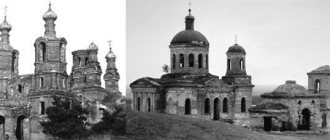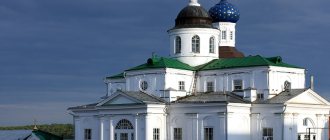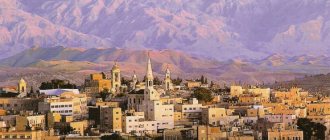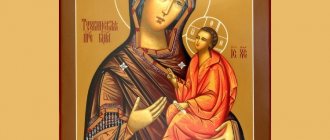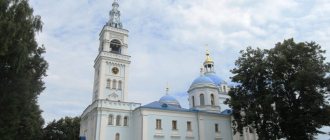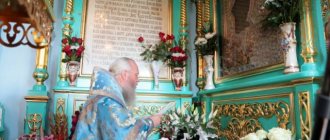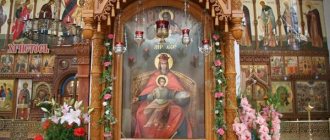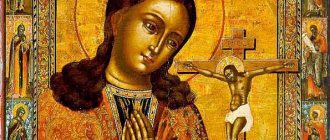Perhaps, of the apostles, not only Luke was an icon painter
— It is generally accepted that the first image of the Mother of God was captured by the Evangelist Luke.
But there are no exact data and documents confirming this? — There is no exact data, because the first mention that the Evangelist Luke was an icon painter dates back to the 8th century AD, this was mentioned by Saint Andrew of Crete. And the Evangelist Luke, as we understand, lived in the 1st century.
Does this prove with any accuracy that the Evangelist Luke was not an icon painter? No, it doesn’t prove it, because it cannot be ruled out that the Evangelist Luke was not only a Greek doctor, but also an artist.
There is no documentary evidence of this. But tradition made him an icon painter. A huge number of icons are associated with his name. According to various estimates, there are about 800 different images in the East and West.
In particular, tradition attributes to Luke the Vladimir image of the Mother of God. True, this legend appears in Russian sources only in the 15th century. Here, too, one can understand the desire of believers to associate the most revered, important images with the most ancient icon painter. Raise these images to the most ancient examples, examples written by the Evangelist Luke himself. And thereby make these examples themselves holy.
What is more important is not that these samples were made specifically by the Evangelist Luke. And the fact is that there were the most ancient prototypes that gave rise to all this variety of types of images of the Virgin Mary with the Child and without the Child, and they refer us to them.
Medieval people, looking at the image of the Mother of God “Oranta” in the altar of the Kyiv Cathedral of Hagia Sophia, quite likely recalled the images of the Blachernae Temple in Constantinople.
Stroganov's copy of the Blachernae Icon of the Mother of God. Tretyakov Gallery
There is an ancient legend that the other apostles were also icon painters.
In particular, there is an Armenian legend that one of the oldest images, if not the most ancient, of the Mother of God was painted by the Apostle John. Moreover, it was written on the tombstone of the Virgin Mary. This icon was kept in one of the Armenian monasteries for centuries.
— There are incredibly many images of the Mother of God written, either 500 or 700. Do they all fit into the canon? When did the canonical image of the Blessed Virgin Mary take shape?
— What do we mean by the word “canon”? If by the word “canon” we mean a certain stable pattern, then this is a late phenomenon.
The culmination of the understanding of the canon as a set of stable schemes took shape in the 18th century, when the vaults of the Mother of God icons appeared.
The vaults of the Mother of God icons are most similar to stamp collections. Usually in the center of such a vault is the main image, chosen at the request of the customer. He is surrounded by many such “stamps” that have a stable iconographic scheme. On one such icon, for example, 120 small images of the Mother of God can be written. Such formalization is a fairly clear sign of an internal crisis in icon painting.
Just like the rigid linking of one or another type of icon to different types of help. Some priests are very fond of explaining that this scheme (this image) helps against drunkenness, another against childbearing, the third against an epidemic...
All these phenomena have little connection with the genuine, ancient Byzantine tradition.
What was in the ancient tradition and how does what we now call the canon appear, namely different types of images of the Mother of God?
Day of the Holy Trinity
Another ten days pass after the Ascension and fifty after Easter, when the Orthodox world celebrates the next great Orthodox holiday. Simply put, it is also called Trinity, Pentecost. The event that led to the appearance of this holiday was the descent of the Holy Spirit on the apostles. When all twelve were assembled, a gust of wind suddenly came and enveloped the apostles in flames. The Holy Spirit declared itself so clearly. From that day on, Jesus’ disciples gained the ability to understand hitherto unknown languages and dialects, and most importantly, to speak them. This blessing was given to them in order to spread the word of God throughout the world, so the apostles went to preach throughout the countries.
In folk tradition, Trinity completed the series of spring holidays - after it the summer season began. They prepared thoroughly for this holiday - a few days before it, housewives cleaned the house, trying to get rid of unnecessary things, and the garden and vegetable garden were cleared of weeds. They tried to decorate their home with bunches of herbs and flowers, as well as tree branches - it was believed that this would bring good luck and prosperity to all its inhabitants. In the morning they went to church for services, and in the evening the festivities began. Young people these days were instructed to be careful - after all, mermaids and Mavkas came out of forests and fields to lure guys into their nets.
Five icons of the Blachernae Temple
Russian Icon with a set of miraculous images of the Mother of God, 19th century
Ancient artists depicted different states - this is the most accurate word - of the Mother of God and highlighted one or another aspect in them.
For example, in the type that we now call “Tenderness,” where the Mother of God presses the baby to her cheek, the deep closeness between the Mother of God and her Son, their closest internal connection, is emphasized.
In the type that we now call the “Sign”, where the Mother of God raises her hands, there is a gesture of intense prayer, which the priest still uses in prayer over the Blessed Sacrament. Liturgical gesture.
In the so-called image of the Mother of God “Paraklisis” (“Prayer”) - in our tradition we often call such an icon the Bogolyubskaya - the icon painter highlighted the moment of the Mother of God’s conversion to Christ.
Some of these images became revered over time and found their place in the most famous temples of the Byzantine Empire. For example, we know that at least five of these important miraculous images of various types were in the Blachernae Church of the Virgin Mary in Constantinople. This was the main temple of Our Lady in the entire Byzantine Empire.
We know for sure that in this temple there was a prototype of what we now call the image of the Mother of God “The Sign” with a medallion on her chest. And also the prototype of the icon that we know as the Vladimir Icon of the Mother of God.
But it cannot be said that there were any sets of schemes, working matrices for images. It’s just that ancient images became revered, and other icon painters created repetitions and replicas of them.
The schemes appeared much later. Researchers of the 19th century studied the existing icon painting schemes and tried to classify them. For example, the great historian of Byzantine art of the 19th century, Nikodim Pavlovich Kondakov, dealt with this a lot. He wrote a classic work in two volumes - “The Iconography of the Mother of God”. But by and large, he didn’t succeed much, because these schemes turn out to be almost endless.
- That is, it cannot be said that we have 3-4 canonical types of images: “Tenderness”, in which the Mother of God hugs the baby, “Oranta” - “The Sign”, in which the Mother of God raises her hands, “Hodegetria” - “Guide” , in which the Infant God holds a scroll in one hand and blesses those praying with the other?
- No. Absolutely. There are many more of them.
Moreover, if we take the so-called “Hodegetria”, then we will see a huge number of options there. The so-called “Aristocratus”, that is, “Left-handed”, and “Dexiocratus”, that is, “Right-handed”. If the position of the Child is one, then in our terminology this icon becomes the “Iveron Icon of the Mother of God”, the other – the “Hodegetria of Constantinople”.
But if we compare the same copies of the Vladimir Icon of the Mother of God, which seem to repeat the basic scheme, for example, the image of Andrei Rublev, with the original - the 12th century icon from the Blachernae Church, we will see a completely different icon, with a different image, with a different meaning.
Motherhood
The naming of the Virgin Mary “Mother of the Lord” (Luke 1:43) finds its explanation in the Christological teaching of the Church. In the Incarnation the hypostatic unity of the Divine and human natures in Christ was realized. Thanks to this unity between both natures, a “communion of properties” occurs (John of Damascus, Exact Exposition of the Orthodox Faith, III, 4), as a result of which the properties and states of one nature are assimilated by the other nature.
"Marriage in Cana of Galilee." Painting of the Cathedral of the Nativity of the Virgin Mary at the Ferapontov Monastery. Master Dionysius. 1502–03. Archive of the "Orthodox Encyclopedia"
According to the testimony of the church historian Socrates Scholasticus, the name “B.” first found in Origen (Socrates Scholasticus, Ecclesiastical History, VII, 32). St. repeatedly calls the Virgin Mary the Mother of God. Athanasius the Great (Alexandrian) (Life of St. Our Father Anthony, 36). K con. 4th century naming "B." became so dogmatically significant that it became a criterion for Orthodoxy. confessions of faith. In 431 the naming "B." was dogmatically consolidated by the 3rd Ecumenical Council. The name “Christ Mother” was not dogmatically fixed, primarily for the reason that it was compromised by the heresy of Nestorius (see Nestorianism).
We understand the canon as a diagram. But the Byzantines thought differently
Icon of Theophanes the Greek “Our Lady of the Don”.
Reproduction by RIA Novosti They understood the canon as the image to which this or that image goes back. This is a completely different methodology, a different type of consciousness. A modern standard icon painter, when, say, he is commissioned for the image of “Tenderness,” rushes to a set of diagrams that appears in Rus' at the end of the 16th century, that is, very late. He finds the “Tenderness” diagram there, transfers this diagram to the board and then colors this image on the board. This is one technique, not at all Byzantine.
Another technique is described by Epiphanius the Wise when he talks about the work of Theophanes the Greek in the Moscow Kremlin. Epiphanius the Wise observed and talked with the great Byzantine master during this work. He specifically emphasizes that Theophanes the Greek does not look at any samples at all.
“When he was drawing or writing all this, no one saw him ever look at the samples, as some of our icon painters do, who, out of lack of understanding, constantly peer at them, moving their gaze from here to here, and not so much paint with paints as look at the samples."
The Byzantine icon painter has no samples. He doesn't have plans in his head. He has images in his head.
This Byzantine approach struck me at the time when I saw a workshop in the Serbian monastery of Vysoki Decani in Kosovo. In the era of tragedies, the separation of Kosovo and Albanian nationalist aggression, a group of wonderful monks came there and began to revive ancient traditions, chants, and icon painting in this terrible environment.
This is a special feat of our days, which few people know about. They created an icon-painting workshop where they tried to revive the traditions of Byzantine icon painting. I saw there how a modern icon painter works. He works like a Byzantine master. This icon painter painted an icon of Christ. Next to his easel, on which stood a board, were five or six reproductions of different images of Christ, starting with the Sinai Pantocrator and up to the image of the 15th century. Masterpieces of Byzantine art. Looking at these different images, inspired by them, he painted a completely different one - his own.
This is approximately what Byzantine artists did, only most of the major masters had these images in their heads. What kind of literal or formal canon can we talk about here?
— So it’s not a matter of not “going beyond”, it’s a matter of wanting to come into contact with a revered image?
— This is the desire to completely and deeply retell the image that you have in your mind and soul, and thereby create new value. This does not require schemes or exotic plots. The plot and all sorts of entertaining narrative details arise when the spiritual essence is lost. As compensation.
“But everyone knows exactly how the Mother of God should be depicted.” The maforium is crimson, the tunic is blue, the hair is hidden, and there are three stars on the maforium. That’s how it’s supposed to be...
— Who is it supposed to be? These are all convenient fictions for craftsmen. I don't mean anything offensive. This is for the art industry. But leading modern icon painters, and thank God we have such, icon painters-artists solve their artistic problems and can do it in different ways. This will be a recognizable image of the Virgin Mary. And it will even be clear what type this image belongs to. But at the same time, all these details, details can be infinitely different. This is a Byzantine tradition.
Image of the Virgin Mary
The face of the Virgin Mary is usually depicted as oval in shape, with an elongated nose, small mouth, almond-shaped eyes wide open, arched eyebrows[1]
The Mother of God is traditionally depicted dressed in a purple omophorion[2] or dark red[3], dark cherry[4], crimson maforium[5] (a married woman’s veil covering her head and shoulders). Maforium is decorated with three golden [4] eight-pointed stars [6] - on the body and shoulders (the symbol of the Holy Trinity, in another interpretation: the symbol of the “Three Virgins of Mary - before the Nativity, at the Nativity of Christ and after the Nativity”). Maforium often has a gold border. In early (pre-iconoclastic) images, the forehead of the Virgin Mary is depicted not with a star, but with a dotted cross. Subsequently, thanks to the diagonal rays, the cross turned into an eight-pointed star[7].
Under the maforium, the Virgin Mary is depicted with a long tunic reaching to the toes with narrow sleeves of light blue[8] or dark blue[5]. From under the maforia on the head of the Virgin Mary a blue cap can also be seen[3]. The Ozeryanskaya icon depicts the Mother of God in a red tunic and blue maforia[9].
The Novgorod icon of the Assumption from the early 13th century depicts the red shoes of the Virgin Mary[10][11].
The inscription on the icon is given, according to tradition, in the Greek abbreviation ΜΗΡ ΘΥ or ΜΡ
ΘΥ
(Mother of God).
The baby in the arms of the Mother of God is dressed in a white (red[9] or ocher[12]) chiton and an ocher (green[12]) himation[1]

